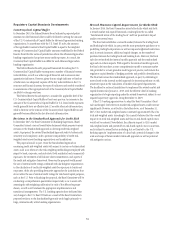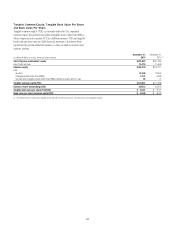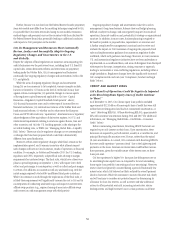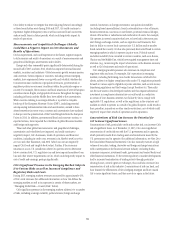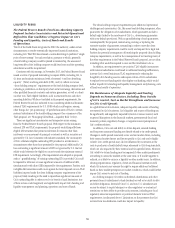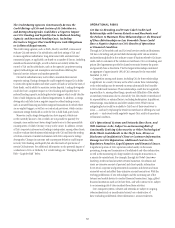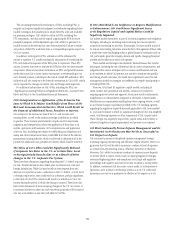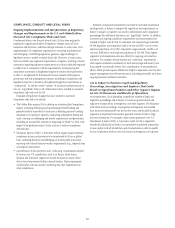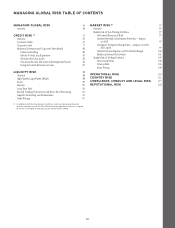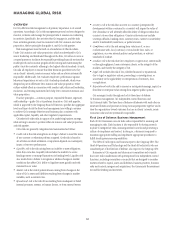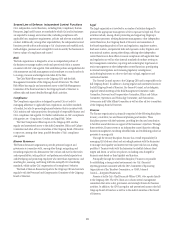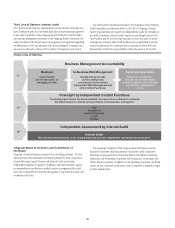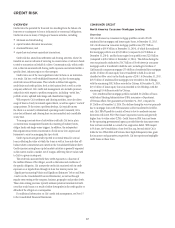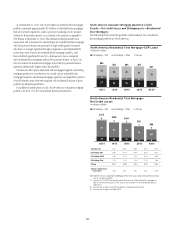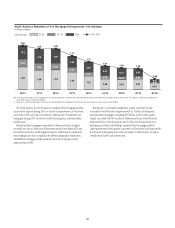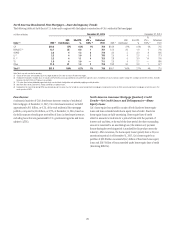Citibank 2015 Annual Report Download - page 78
Download and view the complete annual report
Please find page 78 of the 2015 Citibank annual report below. You can navigate through the pages in the report by either clicking on the pages listed below, or by using the keyword search tool below to find specific information within the annual report.60
Citi’s Ability to Continue to Wind-Down Citi Holdings
Largely Depends on Factors Outside Its Control.
While Citi made significant progress in continuing to wind-down Citi
Holdings in 2015, and Citi expects to maintain Citi Holdings at or above
“break even” in 2016, as of December 31, 2015, the remaining assets in Citi
Holdings largely consisted of North America legacy consumer mortgages, of
which approximately 50% consisted of home equity loans for which a market
for sales has not yet developed. Accordingly, sales of the remaining mortgage
assets will largely continue to be subject to ongoing run-off, market appetite
and/or opportunistic sales. As a result, the remaining assets in Citi Holdings
will not likely decrease as significantly as in prior years and could continue
to have a negative impact on Citi’s risk-weighted assets.
Citi’s Performance and the Performance of Its Individual
Businesses Could Be Negatively Impacted if Citi Is Not
Able to Hire and Retain Highly Qualified Employees for
Any Reason.
Citi’s performance and the performance of its individual businesses is largely
dependent on the talents and efforts of highly skilled employees. Specifically,
Citi’s continued ability to compete in its businesses, to manage its businesses
effectively and to continue to execute its overall global strategy depends on
its ability to attract new employees and to retain and motivate its existing
employees. If Citi is unable to continue to attract and retain the most
highly qualified employees for any reason, Citi’s performance, including its
competitive position, the successful execution of its overall strategy and its
results of operations could be negatively impacted.
Citi’s ability to attract and retain employees depends on numerous factors,
some of which are outside of its control. For example, given the heightened
regulatory and political environment in which Citi operates relative to
competitors for talent both within and outside of the financial services
area, it may be more difficult for Citi to hire or retain highly qualified
employees in the future. Other factors that impact Citi’s ability to attract and
retain employees include its culture, compensation, the management and
leadership of the company as well as its individual businesses, Citi’s presence
in the particular market or region at issue and the professional opportunities
it offers. Generally, the banking industry is subject to more stringent
regulation of executive and employee compensation than other industries,
including deferral and clawback requirements for incentive compensation
and other limitations. Citi often competes in the market for talent with
entities that are not subject to such significant regulatory restrictions on the
structure of incentive compensation.
Incorrect Assumptions or Estimates in Citi’s Financial
Statements Could Cause Significant Unexpected Losses
in the Future, and Changes to Financial Accounting and
Reporting Standards or Interpretations Could Have a
Material Impact on How Citi Records and Reports Its
Financial Condition and Results of Operations.
Citi is required to use certain assumptions and estimates in preparing its
financial statements under U.S. GAAP, including determining credit loss
reserves, reserves related to litigation and regulatory exposures, valuation of
DTAs and the fair values of certain assets and liabilities, among other items.
If Citi’s assumptions or estimates underlying its financial statements are
incorrect or differ from actual future events, Citi could experience unexpected
losses, some of which could be significant.
Moreover, the Financial Accounting Standards Board (FASB) is currently
reviewing, or has proposed or issued, changes to several financial accounting
and reporting standards that govern key aspects of Citi’s financial statements
or interpretations thereof, including those areas where Citi is required to
make assumptions or estimates. For example, the FASB has proposed a new
accounting model intended to require earlier recognition of credit losses
on financial instruments. The proposed accounting model would require
that lifetime “expected credit losses” on financial assets not recorded at fair
value through net income, such as loans and held-to-maturity securities,
be recorded at inception of the financial asset, replacing the multiple
existing impairment models under U.S. GAAP which generally require that
a loss be “incurred” before it is recognized (for additional information
on this and other proposed changes, see Note 1 to the Consolidated
Financial Statements).
Changes to financial accounting or reporting standards or interpretations,
whether promulgated or required by the FASB or other regulators, could
present operational challenges and could require Citi to change certain of
the assumptions or estimates it previously used in preparing its financial
statements, which could negatively impact how it records and reports its
financial condition and results of operations generally and/or with respect to
particular businesses. For additional information on the key areas for which
assumptions and estimates are used in preparing Citi’s financial statements,
see “Significant Accounting Policies and Significant Estimates” below and
Note 28 to the Consolidated Financial Statements.



